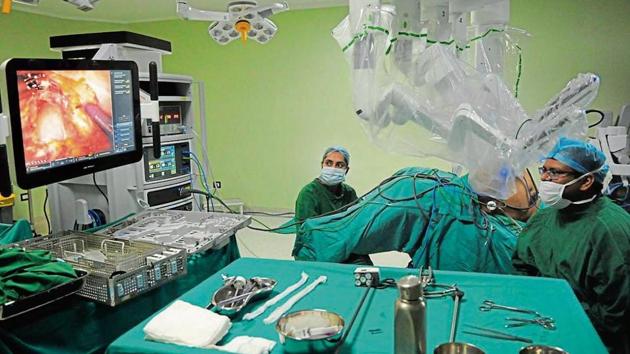
Doctor reveals 6 new hernia treatments that could save you from a lifetime of pain
null | 0 Views
One minute it is just discomfort and the next, it is a life-threatening hernia where your gut might be crying for help as the hernia symptoms could be fatal. One can suffer from a hernia due to an enlarged prostate, obesity, abdominal fluid, lifting heavy weights, constant coughing, straining during urinating, constipation and exertion.
You may be at the risk of getting a hernia due to old age, smoking, pregnancy, low birth weight and constipation. In an interview with HT Lifestyle, Dr Aparna Govil Bhasker (Consultant Bariatric and Laparoscopic Surgeon at MetaHeal - Laparoscopy and Bariatric Surgery Center in Mumbai and Saifee, Apollo and Namaha Hospitals in Mumbai), talked about the advanced techniques for hernia repair and shared that modern surgical methods have significantly improved the outcomes of hernia treatment.

According to Dr Aparna Govil Bhasker, the most recent advance treatments for hernia are:
1. Laparoscopic Hernia Repair
Laparoscopic surgery, a minimally invasive technique that uses a laparoscope—a narrow tube fitted with a camera—to guide the repair. It is performed through tiny sub-centimetre incisions. The abdomen is inflated with carbon dioxide to enhance visibility. Surgical instruments are inserted through these tiny cuts to fix the hernia. A mesh is often placed to strengthen the weak area.
Advantages of laparoscopic hernia surgery include: Reduced hospital stay; Less scarring; Quicker healing; Less likelihood of recurrence.
2. Robotic surgery for hernia repair
Robotic hernia surgery, a complex kind of laparoscopic repair, allows the physician to use robotic arms for precise control. In difficult hernia situations, this approach allows more accuracy, improved visualization, and greater dexterity. The benefits of robotic surgery are: quicker return to normal activities; lower chance of problems; less tissue damage; better accuracy with 3D visualisation.

3. Extended Totally Extraperitoneal (eTEP) Repair
A variant of the traditional laparoscopic approach, the eTEP procedure is meant for complicated and ventral hernias. Because it prevents access into the peritoneal cavity, large hernias can be properly viewed and fixed with less difficulties. Benefits of eTEP are reduction in adhesion formation inside the belly, better mesh implantation with more coverage; less risk of intestinal injury; suitable for individuals who have had previous abdominal surgery.
4. The Transversus Abdominis Release (TAR) Approach
TAR is a sophisticated component separation procedure for big, severe, or recurrent ventral hernias. The transversus abdominis muscle has to be released to allow for the mesh insertion without excessive stress on it. The fundamental benefit of TAR is providing a robust and long-lasting repair. This therapy helps patients with significant abdominal wall abnormalities since it relieves pressure on the abdominal wall and allows the insertion of big mesh, hence reducing recurrence rates.
5. Abdominal wall reconstruction, or AWR
Complicated and recurrent hernias are treated with an advanced surgical procedure called abdominal wall reconstruction (AWR). To restore the integrity of the abdominal wall, a combination of mesh reinforcement, muscle release techniques, and careful closure are used.
Important features of AWR include- TAR and other component separation techniques are used for tension-free closure of large, recurrent, or post-surgical hernias. AWR enhances functional as well as aesthetic outcomes; it is usually combined with robotic or laparoscopic procedures for more accuracy.
6. Enhanced Open Surgery Techniques
Even though minimally invasive methods are ideal, open surgery is still necessary for some large or complicated hernias. In order to reduce post-operative pain and recurrence rates, open hernia repair innovations include the use of sophisticated mesh materials, tension-free techniques, and enhanced wound closure methods.
Post-Operative Care and Recovery
Dr Aparna Govil Bhasker asserted that appropriate post-operative care is absolutely vital for a quick recovery following hernia surgery:
- Using prescribed medications to control pain.
- Maintaining a clean surgical site and following wound care guidelines.
- Avoiding physically demanding activities for at least three months.
- Promoting moderate movement to avoid complications.
Ongoing studies and technical innovations are helping to shape the future of hernia surgery. Safer and more efficient treatments are being made possible by innovations like bioengineered mesh, AI-assisted surgical planning and newer techniques.
Note to readers: This article is for informational purposes only and not a substitute for professional medical advice. Always seek the advice of your doctor with any questions about a medical condition.
Read more news like this on HindustanTimes.com









